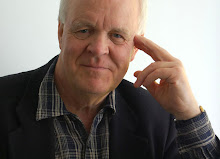Peake at Ledbury
Following my talk at the 2008 Ledbury Poetry Festival Gary Bills-Geddes, a reporter from the local newspaper, wrote the following lines about the illustrated lecture which was held in the town's elegant Burgage Hall. A full house greeted me and following my talk members of the audience asked many questions, with several copies of various books being bought afterwards by members of the enthusiastic audience. The festival was beautifully run and organised by a committed team of dedicated people, whose hospitality and warm welcome needed to be experienced to be believed. I send them all sincere thanks via this website.
Peake's visions of China
From the Ledbury Reporter, first published Thursday 10th July 2008.
"The luminous talent that was author and artist Mervyn Peake was brought to light by his son, Sebastian, during a moving illustrated lecture in the Burgage Hall.
"The event, on Wednesday July 9, would have been Mervyn Peake's 97th birthday, had he not died relatively young from Parkinson's disease. But his work remains, and it is likely to remain.
"My main encounter with that work beforehand was through the famous Gormenghast novels, the Titus Trilogy. I had always assumed that the nightmarish feudal world was a echo of medieval Europe, with its castles and barons and strange religious rituals. So I was surprised to discover that late Imperial China, where Peake grew up, was a major inspiration for Gormenghast.
"Sebastian Peake showed a slide of a typical roofscape of the time, with its pagodas and gables, and the similarity to Gormenenghast became apparent.
"Another misconception was shattered when Sebastian Peake discussed his father's nature. Because of the shadows of Gormenghast, I had assumed that Peake was a gloomy man. But Peake apparently celebrated and enjoyed life.
"This quality would have held him in good stead when he visited Germany after the Second World War, as war artist Captain Peake. He was asked to draw the dying at Belsen concentration camp. Those illustrations are more haunting than any photograph, but all of Peake's illustrations and sketches are marvellous.
"He was well-known as an illustrator long before he started to write the Titus Trilogy, and His drawings for "Treasure Island" and Coleridge's "The Rhyme of the Ancient Mariner" are particularly memorable.
"He was a good poet too, and could write of "the cold corridor of winter nights" and assert that "machines are weaker than a beetle's wing."
"In his life he produced 10,000 drawings, 200 oil paintings and five books. Perhaps "genius", for once, is not too strong a word."
Peake's visions of China
From the Ledbury Reporter, first published Thursday 10th July 2008.
"The luminous talent that was author and artist Mervyn Peake was brought to light by his son, Sebastian, during a moving illustrated lecture in the Burgage Hall.
"The event, on Wednesday July 9, would have been Mervyn Peake's 97th birthday, had he not died relatively young from Parkinson's disease. But his work remains, and it is likely to remain.
"My main encounter with that work beforehand was through the famous Gormenghast novels, the Titus Trilogy. I had always assumed that the nightmarish feudal world was a echo of medieval Europe, with its castles and barons and strange religious rituals. So I was surprised to discover that late Imperial China, where Peake grew up, was a major inspiration for Gormenghast.
"Sebastian Peake showed a slide of a typical roofscape of the time, with its pagodas and gables, and the similarity to Gormenenghast became apparent.
"Another misconception was shattered when Sebastian Peake discussed his father's nature. Because of the shadows of Gormenghast, I had assumed that Peake was a gloomy man. But Peake apparently celebrated and enjoyed life.
"This quality would have held him in good stead when he visited Germany after the Second World War, as war artist Captain Peake. He was asked to draw the dying at Belsen concentration camp. Those illustrations are more haunting than any photograph, but all of Peake's illustrations and sketches are marvellous.
"He was well-known as an illustrator long before he started to write the Titus Trilogy, and His drawings for "Treasure Island" and Coleridge's "The Rhyme of the Ancient Mariner" are particularly memorable.
"He was a good poet too, and could write of "the cold corridor of winter nights" and assert that "machines are weaker than a beetle's wing."
"In his life he produced 10,000 drawings, 200 oil paintings and five books. Perhaps "genius", for once, is not too strong a word."


0 Comments:
Post a Comment
Subscribe to Post Comments [Atom]
<< Home